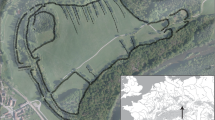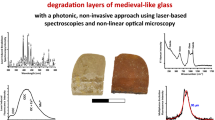Abstract
The aim of the present work is the application of the non destructive techniques of fiber optics microscopy (FOM) and environmental scanning electron microscopy with energy dispersive x-ray analysis (ESEM-EDX), for the characterization of a group of decorated colored glass objects, with relation to the manufacturing technique. All the glasses are in the form of small fragments, which have come to light at archaeological excavations in the area of Dodecanese in Greece and are dated at a period between the fifth and fourth century bc. Today they belong to the National Archaeological Museum of Athens. The great antiquity of the glass fragments did not allow any sampling or even micro-sampling. Thus FOM and ESEM-EDX methods were used for their microscopic examination and elemental compositional analysis. The compositional data obtained led to significant results on the level of the adopted glass technology, suggesting an identification of the coloring agents used for the production of the glass objects colorations: Pb and Sb are indicated as responsible colorants for the opaque yellow decorations, while only Sb is present in the white ones. Green glasses exhibit high levels of Fe. The dark grey coloration is attributed to Ni content, while Fe along with Mn and Ni elements are present in black glasses. Co is found to be the responsible colorant for blue glasses. In this work, the results obtained from the microscopic examination provided substantial information on the level of the employed glass manufacturing technique used, allowing us to assume that the core-forming was the main technique used for the production of the glass artifacts.


























Similar content being viewed by others
Abbreviations
- Ob:
-
Object
- b:
-
Blue
- g:
-
Green
- y:
-
Yellow
- gr:
-
Grey
- w:
-
White
- bl:
-
Black
- sp:
-
Spot
- map:
-
Mapping
- Tot:
-
Total
References
Grose DF (1989) Early ancient glass: core- formed, rod-formed and cast vessels and objects from the Late Bronze Age to the early Roman Empire, 1600 bc to ad 50. The Toledo Museum of Art. Hudson Hills Press, New York, pp 45–72
Turner WES (1956) Studies of ancient glass and glassmaking processes part V. Raw materials and melting processes. J Soc Glass Technol 40:277–300
Turner WES (1956) Studies of ancient glass and glassmaking processes part IV. The chemical composition of ancient glasses. J Soc Glass Technol 40:162–186
Sayre EV, Smith RW (1961) Compositional categories of ancient glasses. Science 133:1824–1826
Henderson J (1985) The raw materials of early glass production. Oxf J Archaeol 4(2):763–780
Goldsetin SM (1979) Pre-Roman and Early Roman glass in the corning museum of glass. New York
Gudenrath W (2004) Techniques of glassmaking and decoration. In: Tait H (ed) Five thousands years of glass (revised edition). British Museum Press, London, pp 21–61
Harden DB (1969) Ancient glass I: Pre-Roman. Archaeol J 125:46–76
Tatton-Brown V, Andrews C (2004) Before the invention of glassblowing. In: Tait H (ed) Five thousands years of glass (revised edition). British Museum Press, London, pp 21–61
Fossing P (1940) Glass vessels before glass-blowing. Ejnar Munksgaard, Copenhagen
Harden DB (1981) Catalogue of Greek and Roman glass in the British Museum, vol I. British Museum Press, London
Arletti R, Vezzalini G, Quartieri S, Ferrari D, Merlini M, Cotte M (2008) Polychrome glass from Etruscan sites: first non-destructive characterization with synchrotron μ-XRF, μ-XANES and XRPD. Appl Phys A 92:127–135
Arletti R, Maiorano C, Ferrari D, Vezzalini G, Quartieri S (2010) The first archaeometric data on polychrome Iron Age glass sites located in northern Italy. J Archaeol Sci 37:703–712
Nikita K, Henderson J (2006) Glass analyses from Mycenaean Thebes and Elateia: compositional evidence for a Mycenaean glass industry. J Glass Stud 48:71–120
Shortland AJ (2002) The use of antimonate colorants in early Egyptian glass. Archaeometry 44:517–530
Shortland AJ, Eremin K (2006) The analysis of second millennium glass from Egypt and Mesopotamia, part 1: new WDS analyses. Archaeometry 48(4):581–605
Sokaras D, Karydas AG, Oikonomou A, Zacharias N, Beltsios K, Kantarelou V (2009) Combined elemental analysis of ancient glass beads by means of ion beam, portable XRF, and EPMA techniques. J Anal Bioanal Chem 395:2199–2209
Tite M, Shortland A, Maniatis Y, Kavoussanaki D, Harris S (2006) The composition of the soda-rich and mixed alkali plant ashes used in the production of glass. J Archaeol Sci 33:1284–1292
Tite M, Pradell T, Shortland A (2007) Discovery production and use of tin-based opacifiers in glasses, enamels and glazes from the late Iron Age onwards: s reassessment. Archaeometry 50:67–84
Walton M, Shortland AJ, Kirk S, Degryse P (2009) Evidence for the trade of Mesopotamian and Egyptian glass to Mycenaean Greece. J Archaeol Sci 36:1496–1503
Henderson J (2000) The science and archaeology of materials. An investigation of inorganic materials. Rutledge, London, pp 29–38
Lilyquist C, Brill RH (1993) Studies in early Egyptian glass. The Metropolitan Museum of Art, New York
Sayre EV, Smith RW (1967) Some materials of glass manufacture in antiquity. In: Levey M (ed) Archaeological chemistry. University of Pennsylvania Press, Philadelphia, pp 279–312
Rehren Th (2008) A review of factors affecting the composition of early Egyptian glasses and faience: alkali and alkali earth oxides. J Archaeol Sci 35:1345–1354
Turner WES, Rooksby HP (1959) A study of opalising agents in ancient opal glasses throughout three thousand four hundred years. Glastechnishe Berichte 32K(VIII):17–28
Turner WES, Rooksby HP (1961) Further historical studies based on x-ray diffraction methods of the reagents employed in making opal and opaque glasses, vol 8. Germanishen Zentral museums, Jahrbuch des Romish, pp 1–16
Acknowledgements
Authors would like to thank Prof. T. Theophanidis for his outstanding contribution to the paper providing significant suggestions and amendments.
Author information
Authors and Affiliations
Corresponding author
Rights and permissions
About this article
Cite this article
Cheilakou, E., Liarokapi, N. & Koui, M. Non destructive characterization by FOM and ESEM-EDX of ancient glass objects from the Aegean with an approach of the manufacturing technique. Mater Struct 45, 235–250 (2012). https://doi.org/10.1617/s11527-011-9762-5
Received:
Accepted:
Published:
Issue Date:
DOI: https://doi.org/10.1617/s11527-011-9762-5




